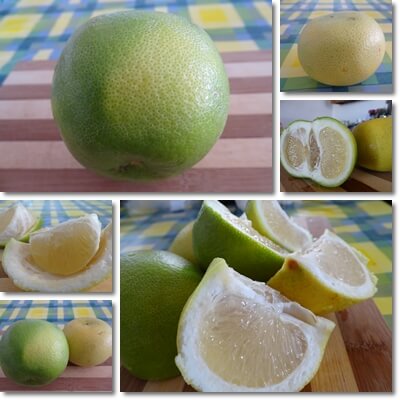The oroblanco or sweetie is a cross between a pomelo and a grapefruit. It is a citrus fruit hybrid, like sweet oranges, lemons and grapefruits. The oroblanco is a good source of vitamin C and potassium and holds benefits for the immune system, teeth and gums, skin and blood pressure. It’s otherwise modestly nutritious, providing only small amounts of several B vitamins and dietary minerals.
Other benefits of oroblanco include anti-inflammatory and digestive benefits from vitamin C, bitter-tasting compounds and dietary fiber. While a healthy fruit for the winter, it’s best to avoid eating too much oroblanco if you are currently on diabetes medication or have acid reflux or gastritis.
What is oroblanco or sweetie?
The oroblanco or sweetie is a hybrid citrus fruit resulting from the crossing of the pomelo (scientific name: Citrus maxima or Citrus grandis), which is an original citrus fruit, and the grapefruit (scientific name: Citrus paradisi).
The grapefruit itself is a citrus fruit hybrid resulting from crossing pomelos and oranges (Citrus sinensis). Judging by its ancestry, it would seem the oroblanco is more pomelo than grapefruit, despite being called the oroblanco grapefruit.
An alternative spelling is oro blanco, meaning white gold, a reference to its flesh color that is similar to that of the white pomelo and white grapefruit (although not actually white).
Another popular name for the pomelo-grapefruit hybrid is sweetie, a name indicative of the pleasant sweet taste of the ripe oroblanco fruit – unlike pomelos and grapefruits, the oroblanco is aromatic and sweet, a trait that has maybe been passed down from sweet oranges.

The oroblanco is said to have been developed by the University of California Citrus Experiment Station, a research project founded over 100 years ago and centered on the development of agriculture in California.
In the 1980’s, the focus centered on citrus agriculture resulted in the development of the variation now known as the oroblanco, or the oroblanco grapefruit or the green grapefruit. Others soon followed, such as the melogold grapefruit.
The oroblanco has been successfully cultivated in Israel under the popular name sweetie or ‘Sweetie’ since the 1980’s. You can buy the tree online or directly from nurseries (it’s likely available in most areas where citrus fruits are extensively cultivated), but remember to research the variety’s growing requirements first.
What does the oroblanco look like?
Some fruit are round or flattened, usually about the size of a medium to large grapefruit (but nowhere near the size of a pomelo). Unripe oroblanco have a lime green rind that turns a paler, pomelo-like yellow when ripe. The rind is soft and smooth, slightly thicker than that of a grapefruit, with lots of dimples. Between the rind and the flesh there is a thick albedo or pith, a spongy, white, but edible tissue.
Inside, the flesh is segmented and covered in a thin, white skin – similar to oranges, grapefruits and pomelos. The flesh is actually cream-colored, not white (as the name oro blanco – white gold – suggests). While the oroblanco is said to be seedless, you can find several dried out, pointy, white seeds in some of the fruit segments, but they are usually underdeveloped.
What does oroblanco taste like?
The oroblanco tastes a little like a pomelo, a little like a grapefruit and a little like a sweet orange. It has a strong citrussy odor to it, that you can smell on it even before opening it up.
The ripe pulp, which is cream-colored and juicy, tastes quite pleasant: mildly sweet, but extremely aromatic, with a faint, but persistent bitter aftertaste and just a bit of a tang. Despite being marketed as having a lime-green rind, the oroblanco does ripen to a pale yellow, pomelo-like color.
Most important, it’s good to eat when it’s both green and pale yellow, although I have to say it’s a lot better-tasting and flavorful when it’s yellow. And it ripens on the kitchen counter in just a few days, sitting nicely in a bowl with a few bananas. The white pith or albedo and the thin, white membranes making up the fruit segments taste bitter.
How to eat it Oroblanco Sweetie
How do you eat oroblanco? Just like you would an orange or grapefruit or pomelo or any other citrus fruit. You cut the rind with a knife to aid with peeling or simply peel the rind with your nails. The thick pith or albedo is removed easily along with the rind. Then you either eat the fruit segments whole, or peel the white membrane and eat only the pulp inside. Ripe oroblanco makes a particularly fragrant and refreshing juice. You can also add it to salads to add flavor. The oroblanco is in season starting October and is available throughout the winter, making it a wonderful choice for anyone who doesn’t like the bitterness of grapefruits, the acidity of oranges or simply wants a fruit smaller than a pomelo.

Oro blanco vs pomelo vs grapefruit
Vs pomelo, the oro blanco is a lot more flavorful, with a stronger citrussy perfume and a sweeter taste. It’s also slightly acidic, which gives it a pleasant tang and adds to its savor. Vs grapefruit, the oro blanco is a lot less bitter-tasting, with only a faint bitter aftertaste, but I find the bitterness is persistent, lingering in the mouth for minutes. While it has a milder, sweeter taste similar to pomelo, and a slight bitterness to it similar to grapefruit, and a cream-colored flesh similar to both the white pomelo and the white grapefruit, the oro blanco is neither fully a pomelo, nor fully a grapefruit.
Nutrition facts of Oroblanco Sweetie
Being part pomelo and part grapefruit, the oroblanco or sweetie shares the nutrition of pomelos and grapefruits. That is, it’s a good source of vitamin C, providing anywhere from 30 to 60 mg of vitamin C per 100 g. It is a modest source of several B vitamins, including vitamins B1, B2, B3, B5 and B6. Fruits with seeds also provide trace amounts of vitamin E. Oroblanco is a good source of potassium, providing between 150 mg and 200 mg of potassium per 100 g. It also contains trace amounts of other essential vitamins and minerals, including iron, calcium, magnesium, manganese, phosphorus and zinc. Other relevant nutrition facts include: good source of dietary fiber (1 g of fiber/100 g), low in calories (around 40 kcal/100 g), low in fat and low in protein (less than 0.5 and 0.8 g/100 g) and a moderate source of carbohydrates (between 8.5 and 9.5 g of carbs, of which 7.5 g sugars).
What are the benefits of Oroblanco Sweetie?
- Because it’s low in calories, oroblanco is a good food to eat for healthy weight loss.
- High in water and a good source of dietary fiber, it helps relieve constipation.
- Minor benefits for digestion thanks to bitter compounds which stimulate appetite and aid digestion.
- Moderate source of carbs and sugar, but good source of dietary fiber – has blood sugar-lowering properties (although compounds in oroblanco may interact with diabetes medication).
- Source of the antioxidants naringenin and naringinin and other flavonoids which reduce oxidative stress, reducing cell damage, and other therapeutic properties.
- Antiviral, antibacterial and immune system modulating properties from vitamin C.
- Good for healthy teeth and gums thanks to a good vitamin C content.
- Anti-aging benefits: vitamin C stimulates collagen production for better skin elasticity and less wrinkles.
- Anti-inflammatory properties from vitamin C.
- Restorative and tonic properties thanks to B vitamins, iron and other dietary minerals.
- Minor benefits for high blood pressure thanks to a good potassium content and no sodium.
What are the side effects of Oroblanco Sweetie?
- Medicine interactions. Just like the grapefruit, the oroblanco has the potential to interact with diabetes medication, high blood pressure medication, antidepressants, anticoagulants, anti-arrhythmia, cholesterol-lowering medication and more. For this reason, the fruit and its juice are best avoided in large amounts if you are receiving treatment for any chronic condition. It’s best to bring it up with your doctor if you are planning on eating the fruit regularly.
- Possibly bad for acid reflux and gastritis. Although only slightly acidic, oroblanco may cause stomach upset in acid reflux and gastritis.
